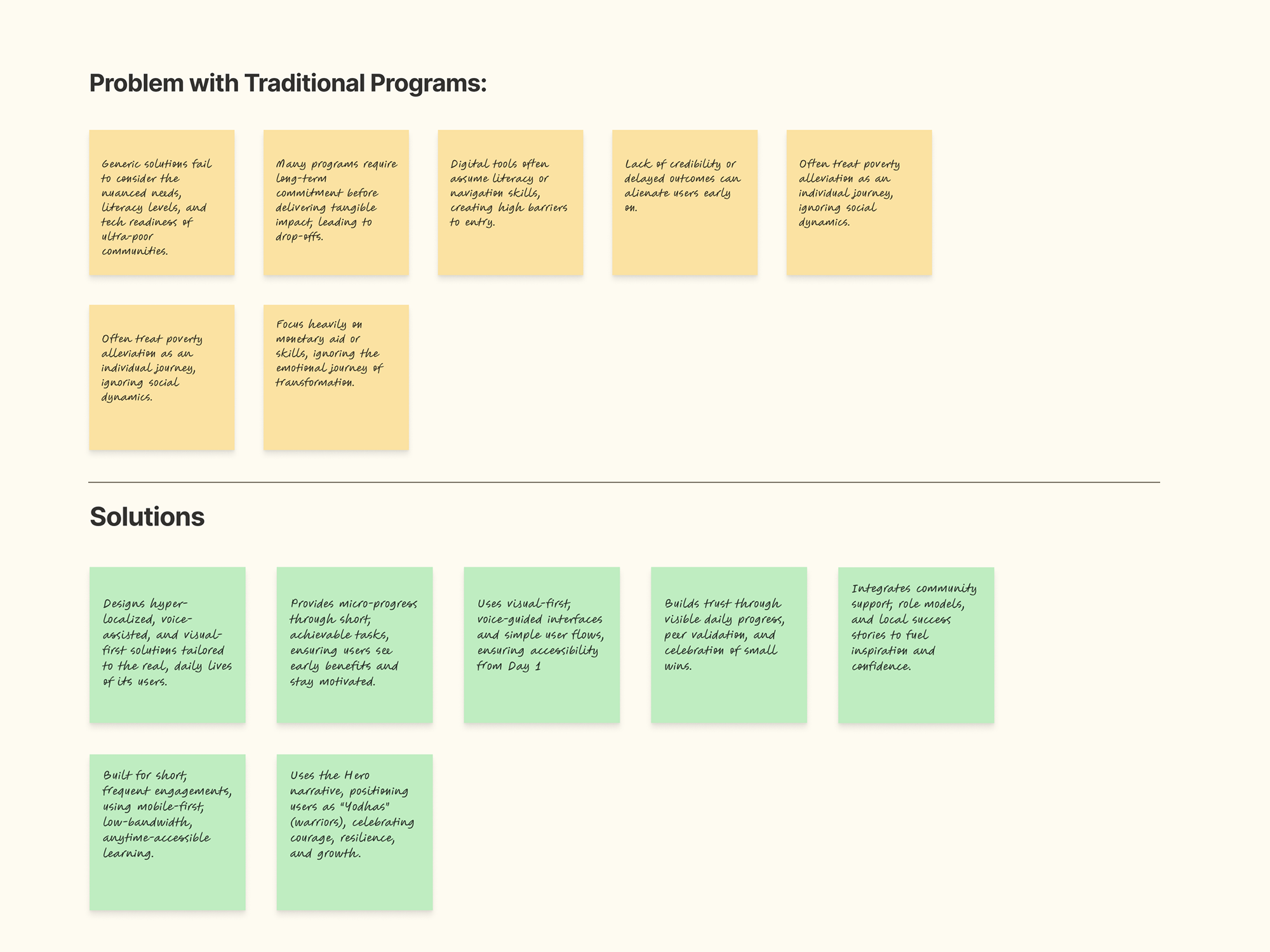Designing for the Invisible India
PROJECT:
Leap 300 A bold, tech powered mission to end extreme poverty in 300 days.
Using Human Centered Design (HCD)
TOOLS:
Figma, Procreate, Adobe Express, Protopie
PLATFORM:
Android
ROLE:
Product Design, Illustration, and Support for Research and Operations Teams
Challenge
How do you design technology for people with no access to the internet, limited literacy, and daily survival struggles yet expect them to become financially independent?
That was the audacious challenge we faced at Leap 300, an initiative by the Leap India Stack Foundation. The goal was simple but profound: eradicate extreme poverty in 300 days, using technology as the primary lever.
But simple goals rarely mean simple paths.
Our target users? Widows, disabled individuals, landless laborers individuals living in the harshest socioeconomic realities. They weren’t just underserved; they were often invisible in the digital world.
We needed more than technology.
We needed empathy.
We turned to Human Centered Design (HCD).
Problem Statement
Despite India’s economic progress, extreme poverty persists especially among marginalized groups with no assets, limited education, and unstable incomes. Traditional programs often fail due to:
Scalability issues Difficult to reach millions effectively
Inefficient resource allocation Funds don’t always reach the right people
Lack of continuous support One time interventions don’t create lasting impact
Leap 300’s tech-driven approach solves these challenges by delivering scalable, rapid, and effective poverty eradication solutions within 300 days.
Meeting People, Not Personas
We didn’t start with wireframes.
We started with conversations.
We walked through dusty lanes in rural Dewas, Madhya Pradesh. We sat on charpoys and kitchen floors. We listened—not just to needs, but to stories, to silences, to fears too fragile for words.
This is where Human-Centered Design came alive not as a methodology, but as a mindset.
Every insight we gathered was earned through trust, not surveys.
We met Arun.
We met Shanti.
And everything changed.


Key Insights
Local Context Matters Traditional programs fail with generic solutions. Users need hyper-local, visual, and voice-guided tools tailored to their real-world challenges.
Quick Wins Build Trust Ultra-poor users seek immediate, visible outcomes. Long-term promises without short-term gains lead to dropouts.
Low Literacy, High Potential Many users can’t read or navigate complex apps. Simple, visual-first interfaces are essential for engagement and success.
Skepticism is High Years of unmet promises make users cautious. Trust is earned through daily progress and small victories.
Community Drives Action People learn better through peer influence. Community-based support and local success stories boost confidence.
Short, Flexible Use Busy lives mean users prefer brief, frequent interactions over long sessions.
Empowerment, Not Just Aid Users want to feel seen and valued. Recognition and emotional upliftment are key to sustained engagement.
Generating Solutions
Stakeholder workshops were conducted to co-create solutions with beneficiaries, field experts, and community leaders. Ideas were refined through multiple iterations, leading to a three-pillar approach:
Unconditional Micro-Entrepreneurship Grants (UMG): Direct cash grants to enable small business creation.
Tech Based Skilling: A voice-assisted Learning Management System (LMS) for business training in local languages.
Lifetime Support: Community networks, digital tools, and mentorship programs for long-term success.

Low-Fidelity Sketches
We created quick, simple sketches to bring user insights to life and shape early concepts:
Voice Navigation: Mic icon + tap-to-speak for tasks like “Start Business.”
Visual Learning: Image-based modules with voice narration for training.
Accounting Icons: Color-coded tabs for income, expense, and savings.
Step-by-Step Tasks: Simple, gamified checklist with rewards.
These sketches made testing faster and more focused. Users appreciated the clarity, visuals, and local language audio.
Digital Ecosystem & Mentorship
Lifetime community linkages connect beneficiaries with local mentors and peer groups, while also offering shock-support to handle emergencies like illness, loss, or income disruptions. This ensures long-term business continuity and confidence.
Learning Management System (LMS)
🎧 A voice-assisted, local-language LMS delivers personalized training tailored to each beneficiary's profile, education level, and type of business. It breaks down complex concepts into actionable steps using audio prompts, real-world examples, and visual storytelling.
Accounting Feature
Visual Accounting for Business P&L and expense management.
Leap 300 users often lack formal education, financial literacy, and confidence in managing money. To help them succeed, we introduced visual accounting tools that replace complex spreadsheets and jargon with:
Color-coded icons for income, expense, and savings
Voice-guided entries for logging transactions
Based on Research
Most users are first-time smartphone users with limited literacy—they need intuitive tools
Traditional financial apps are overwhelming; visuals reduce cognitive load
High-Fidelity Prototypes & Testing
Interactive prototypes were tested with real users in rural areas. Key findings:
Users appreciated voice assistance but struggled with navigation.
Limited literacy necessitated more visual and audio cues.
Iterations improved navigation flow and optimized voice command accuracy.
Tested Where It Matters
Every design choice was stress tested in chaos kids crying, cows mooing, phones half-charged.
We watched fingers hover in hesitation. We redesigned.
We saw confusion in Shanti’s eyes. We simplified again.
Every iteration was a step toward building trust.
Results That Speak Louder Than Features
To measure impact with integrity, we partnered with BITS Pilani for a Randomized Control Trial
a bold, rare move in social innovation.
In 300 Days:
80% moved out of extreme poverty
200% rise in monthly income
210% growth in savings
36% rise in school attendance
68% better household nutrition
34% acquired productive assets
This wasn’t charity.
It was system redesign.
What We Learned
What Worked:
Voice-first tech meets low-literacy users where they are
Early wins fuel trust and commitment
Hyper-local community support sustains engagement
What Was Hard
Tech intimidation runs deep it takes love to uproot it
Motivation fluctuates gamification and nudges are next
What’s Next:
Gamify learning for deeper curiosity
Use AI to offer custom nudges and micro goals
Scale to new regions with similar challenges










